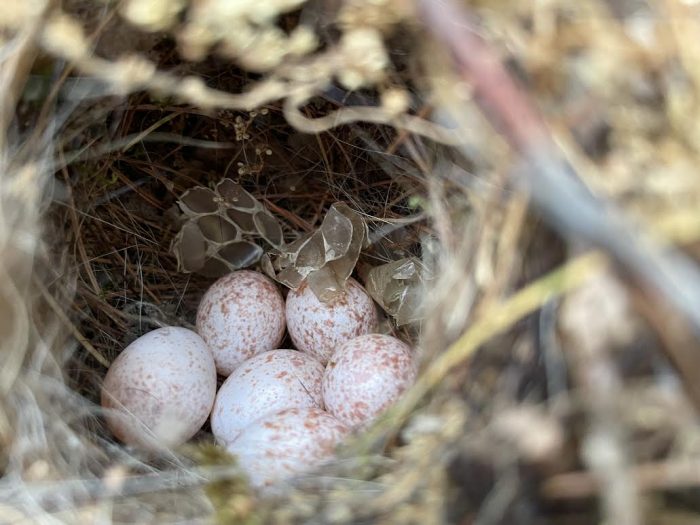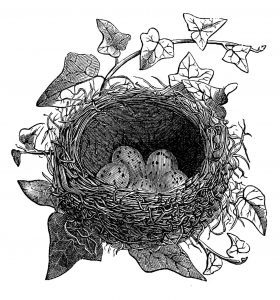Nature Matters: Bird Homes

By John L. Turner

On one of many strolls to the compost bin this Spring, I walked past a tall Norway spruce and noticed the head of a Mourning Dove jutting above a few head-high horizontal branches. Suspecting it was an incubating bird on a nest, I didn’t disturb her, giving her and the long horizontal branch wide berth. Later in the day when the nest was temporarily unattended I moved in for a closer look.
Two eggs sat together in a shallow bowl made of small branches, in a splayed out pattern reminding me a little of the pattern that happens during a game of pick-up sticks. This was not a tightly woven nest and even with the spruce branches supporting it I could see small holes through the nest and branches to the ground below. I wondered if eggs or young ever fall through the doves’ nest although I suspect they don’t.
Mourning Dove nests are known to be loosely constructed in which you typically see through the floor, a trait that makes them distinctive. Some other bird nests also are distinctive to species, the pendulous, highly interwoven nest of a Baltimore Oriole being an excellent example. Their nests, hanging from the end of maple branches, often become apparent after leaf fall in the autumn. Another distinctive nest is that of the American Robin, always containing mud in the outer shell that helps to keep the cup rigid and firm.
Not surprisingly, many birds try to conceal their nests or make them less visible. The Ruby-throated Hummingbird, for example, embellishes the outer sides of its tiny nest with lichens, making it appear to be little more than a lichen-encrusted bump on a branch. Ground nesting birds like Eastern Meadowlarks have nests with an entrance hole on the side making the nest invisible from above. The same is true for the Ovenbird, a warbler species which is a common nester in woodlands throughout Long Island and especially the Pine Barrens. Its ground nest also has an entrance from the side and looks like an old fashion dutch oven, hence the bird’s name.
Bird nests come in many shapes and sizes, constructed with many materials, in many different physical locations, and are a perfect blend of form and function. The purpose is, of course, to provide a place where the eggs, hatchlings, and nestlings can be more safely protected and for many species to successfully complete their development. (Precocious young such as piping plover chicks leave the nest at birth never to return).
Remarkably, a few birds like the Fairy Tern of the South Pacific make no nest at all; this species lays its one egg in a dimple or depression on a thicker branch. Somehow through the rigors of incubation and hatching the egg and chick defy gravity and stay safe. Closer to home we have the “nests” of Whip-poor-wills and Chuck-will’s-widows which are nothing more than leaves on the ground upon which the adult lays her two lightly splotched eggs.
Piping Plovers do a little more in nest construction by hollowing out a small depression with the male adorning the nest with white shell fragments. The nests of terns are similar, being nothing more than a shallow depression in the sand — simple but effective.
The use of earthen burrows — horizontally oriented tunnels of varying lengths with an entrance hole excavated in a vertical surface — is another nesting strategy employed by some birds. On Long Island there are three burrow-nesting birds — the Belted Kingfisher and two swallow species — Bank and Northern Rough-winged. They excavate the tunnel (sloping it slightly upward to keep the rain out) which can be as long as five feet ending in a slightly enlarged chamber where the eggs are incubated. All are dug into a vertical face such as a steep slope, road or railroad cut, bank of a sandpit or in a bluff face. The bluffs along Long Island’s north shore are often used, especially by Bank Swallows. If you walk along a north shore beach flanked by a bluff you might see many small nest holes in the bluff, with handsome brown and white birds with a distinct upper chest band zooming about — you’ve entered a Bank Swallow colony.
Cavities comprise another important nesting strategy employed by birds. Usually the result of work by woodpeckers such as Red-bellied, Hairy, and Downy Woodpeckers, (but not always as I once watched a pair of Black-capped Chickadees excavate a nesting cavity in a rotted grey birch stump), these created cavities are vital to the many bird species that utilize or require cavities in which to nest. These species include the familiar aforementioned Black-capped Chickadee, Tufted Titmice, White-breasted Nuthatch, Great-crested Flycatcher and Screech Owl, not to mention many woodpecker species and numerous insect and mammal species too.
The overwhelming number of birds including most songbirds make nests having two to three distinct layers — coarser sticks in the outer frame, finer twigs and roots in the inner cup, which is lined with soft material such as moss, animal hair, and feathers. This provides necessary rigor while providing a softer surface for the eggs and young.
Birds put some quirky stuff in their nests. Ospreys are notorious for placing all manner of junk in their large nests — pack rats with wings! According to Alan Poole’s fine book “Ospreys: The Revival of a Global Raptor,” materials found in this species’ nests include pieces of fishing nets, plastic buoys, six-pack holders, party balloons and their dangerous ribbons; basically nest materials “can be a bizarre reflection of what is available in the local landscape.” Carolina Wrens and Great Crested Flycatchers are known to reliably include a strange material in their nests — pieces of or entire snakeskins. Speaking of Carolina Wrens, they’re known to nest in some pretty weird spots such as old shoes, flower pots, and pails.
As expected, larger birds make larger nests. The Bald Eagle has perhaps the most impressive nest of any North American bird species; some are large enough for a small child to nestle in the bowl of the stick-constructed nest. According to reports they can weigh nearly a ton (I remember seeing one such massive nest in coastal Maryland several decades ago). Not surprisingly, their nests are typically constructed in large trees with thick branches that can support the weight of the nest. Osprey nests are smaller but still can be impressive affairs, composed of interlocking sticks that stand up to the buffeting winds of the coast.
A few birds, the Great Horned Owl being a classic example, rarely make their own nest, rather using the nest site of a previous occupant such as another bird of prey or crow.
Almost as diverse as the birds themselves, the nests birds construct illustrate many different designs and a wide variety of forms — all variations to achieve the same purpose — a place where bird eggs and babies can be protected at a most vulnerable time in their lives. There’s avian architecture on display all around us!
 A resident of Setauket, author John Turner is conservation chair of the Four Harbors Audubon Society, author of “Exploring the Other Island: A Seasonal Nature Guide to Long Island” and president of Alula Birding & Natural History Tours.
A resident of Setauket, author John Turner is conservation chair of the Four Harbors Audubon Society, author of “Exploring the Other Island: A Seasonal Nature Guide to Long Island” and president of Alula Birding & Natural History Tours.






